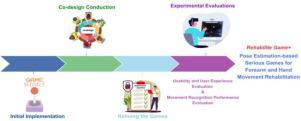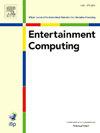康复游戏+:基于姿势估计的前臂和手部运动康复严肃游戏
IF 2.4
3区 计算机科学
Q2 COMPUTER SCIENCE, CYBERNETICS
引用次数: 0
摘要
手部和前臂的运动后遗症可由各种疾病或损伤引起。因此,患者有限制或无法进行运动。运动康复的严肃游戏可以激励患者进行恢复受损肢体所需的锻炼。本研究旨在扩展一个游戏平台,开发和评估专注于手部和前臂运动康复的严肃游戏,然后创建康复游戏+。为了开发它,与21名卫生专业人员(16名物理治疗师和5名心理学家)使用了共同设计方法。结果是一个需求列表,在两个基于人手姿势估计的游戏中实现。之后,在可用性和用户体验研究中,21名物理治疗师首先使用系统可用性量表(SUS)和用户体验问卷(UEQ)对康复游戏+进行了评估。此外,36名健康参与者对游戏中使用的动作识别技术的表现进行了评估。在100分制中,SUS的平均得分为92.5分,在其基准的六个因素中,UEQ结果在1.46到1.98之间变化,在-3到+3之间变化,因此代表良好/优秀的结果。运动识别技术表现出较高的性能(前臂旋前和旋后分别为0.98和0.99,手指屈伸分别为1.00)。我们的结论是,所提出的游戏可以在患者的临床试验中进行实验。本文章由计算机程序翻译,如有差异,请以英文原文为准。

Rehabilite Game+: Pose estimation-based serious games for forearm and hand movement rehabilitation
Motor sequelae in the hand and forearm can result from various diseases or injuries. As a result, the patient has limitations or inability to perform movements. Serious games for motor rehabilitation can motivate patients in the exercise sessions needed to recover the compromised limb. This study aimed to extend a game platform, developing and evaluating serious games focused on the rehabilitation of hand and forearm movements, then creating the Rehabilite Game+. To develop it, a co-design methodology was used with 21 health professionals (16 physiotherapists and 5 psychologists). The result was a list of requirements, which were implemented in two games based on human hand pose estimation. After that, the Rehabilite Game+ was first evaluated with 21 physiotherapists in a usability and user experience study applying the System Usability Scale (SUS) and User Experience Questionnaire (UEQ). Also, movement recognition techniques employed in the games had performance evaluated with 36 healthy participants. The average score of SUS was 92.5 on a 100-point scale and UEQ results varied between 1.46 and 1.98 for six factors within its benchmark, which varies on a scale from -3 to +3, so representing good/excellent results. Movement recognition techniques demonstrated high performance (F1-score of 0.98 and 0.99 for forearm pronation and supination, respectively, and 1.00 for finger flexion and extension). We conclude that the proposed games can be experimented in clinical trials with patients.
求助全文
通过发布文献求助,成功后即可免费获取论文全文。
去求助
来源期刊

Entertainment Computing
Computer Science-Human-Computer Interaction
CiteScore
5.90
自引率
7.10%
发文量
66
期刊介绍:
Entertainment Computing publishes original, peer-reviewed research articles and serves as a forum for stimulating and disseminating innovative research ideas, emerging technologies, empirical investigations, state-of-the-art methods and tools in all aspects of digital entertainment, new media, entertainment computing, gaming, robotics, toys and applications among researchers, engineers, social scientists, artists and practitioners. Theoretical, technical, empirical, survey articles and case studies are all appropriate to the journal.
 求助内容:
求助内容: 应助结果提醒方式:
应助结果提醒方式:


